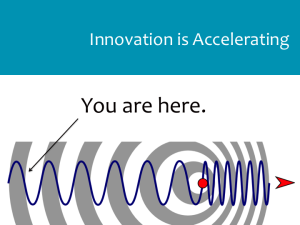 I had the honor of delivering a presentation and serving on the Social Technologies for Industry panel at the Seventeenth Annual ARC World Industry Forum in Orlando. The topic was The Social Media Doppler Effect.
I had the honor of delivering a presentation and serving on the Social Technologies for Industry panel at the Seventeenth Annual ARC World Industry Forum in Orlando. The topic was The Social Media Doppler Effect.
For those unfamiliar with the Doppler effect, if you’re standing still and an object is coming towards you, the sound it emits has a higher pitch when moving toward you than when it’s moving away. Well, if social media made a noise, for most organizations it would sound like it’s moving away.
I’ve been doing inbound marketing evaluations for various companies for several years now. I take a look at their overall web presence and grade it against 26 different criteria that provide a rough indication of how well they are or are not they are implementing the principals of inbound marketing.
In the process of performing these evaluations, I noticed a trend. The thing that I noticed is that although most of these companies are beginning to take a stab at inbound marketing, their grades were getting worse. If they’re finally beginning to drink the Kook Aid, why is this happening?
Well, it turns out that at least in this case, slow and steady is not winning the race. They’re simply not moving fast enough. The size, shape and contents of the Internet in general – and social media in particular – are all changing at faster pace than the companies who are using them. Not only are they changing faster, that change is accelerating and the situation is getting worse by the day. That low pitched hum you hear is the sound of the Social Media Doppler Effect.
So how does an organization get in front of the train rather than behind it?
Hockey legend Wayne Gretzky said it best when asked how he became such a prolific scorer. His answer was that he always would skate to where the puck was going to be, not where it has been.
It sounds simple and obviously it takes a combination of incredible instincts and phenomenal talent in order to pull this off. In this presentation I provide some answers to this by providing a massive case study and then examining how you might apply some of the lessons from that example in your own businesses.
Social Media Innovation is Accelerating
Think about how business was conducted in the 80s and 90s. How often did a true game-changing technology come around? Fax machines, personal computers, mobile phones, the Internet… these things happened maybe every couple of years. Thanks to Moore’s Law and social media, we’re seeing game-changers every couple of months now.
I’ve identified three reasons why I think this is happening:
- Fast growth begets FASTER growth. Reason number one for the innovation acceleration is the breathtaking adoption rates for new social media platforms. Google likes to brag about how quickly its Google+ platform grew its user base, but as far as I’m concerned it’s because they stood on the shoulders of giants. Social media is making discovery of new social media faster and more viral than ever before.
- The second phenomenon that’s fueling accelerating innovation is mobile influence. Surveys show that mobile browsing is not happening instead of desktop browsing. Rather, it’s happening in addition to it. If you look at industry surveys that dive into how and where people are using their smartphones, you discover they’re not just using them MORE, they’re using them DIFFERENTLY.
- You can see this acceleration in a number of areas. I put together a chart of the number of “major” Google algorithm updates over the last six years. As you can see, this chart is nowhere near linear. It’s geometric. As a practical matter, this means that at least half of the search engine optimization tactics you used three years ago are completely useless now. It also means that reviewing your SEO strategy once a year was probably fine as recently as 2009 but in 2013 you better be tearing up your old strategy once a year and revisiting it quarterly.
To see a case study of a digital marketing campaign that figured this out and see a few suggestions about how to get in front of the social media train, check out this video of the full presentation:


Trackbacks/Pingbacks